Introduction
It is not always easy to walk the line between quality and value for money but Sofirn seems to have mastered the skill well. About a month ago I reviewed their EDC style torch, Sofirn SC31 Pro, and it was so good for its price that it peaked my curiosity. It therefore prompted me to have a look at their bigger and brighter models.
I asked their representative and she obliged by sending me the Sofirn SP36 Pro, a 8000 lumen lighirnt with Andúril firmware, 4 LEDs and 3 batteries.

This is by no means an EDC light. Its size puts it in the Soda Can lights category, albeit on the thin side of the genre. The generous specs and competitive pricing make for a combination that is hard to beat.
But let's not get ahead of ourselves. We need to see the light first and what it can do.
Unboxing
The Sofirn SP36 Pro comes in an unassuming, generic brown cardboard box with a barcode sticker that provides information about the contents.


Inside the box, we find the light, protected in bubble wrap, a 1 meter long USB A to USB C charging cable, 2 spare O-rings and the manual.


The light comes with a little tag, secured around the body with a rubber band.

The tag explains that there is an insulator in the battery compartment, stopping the batteries from making contact and thus rendering the light inoperable for safe shipping. The insulator needs to be removed before the light can be used.
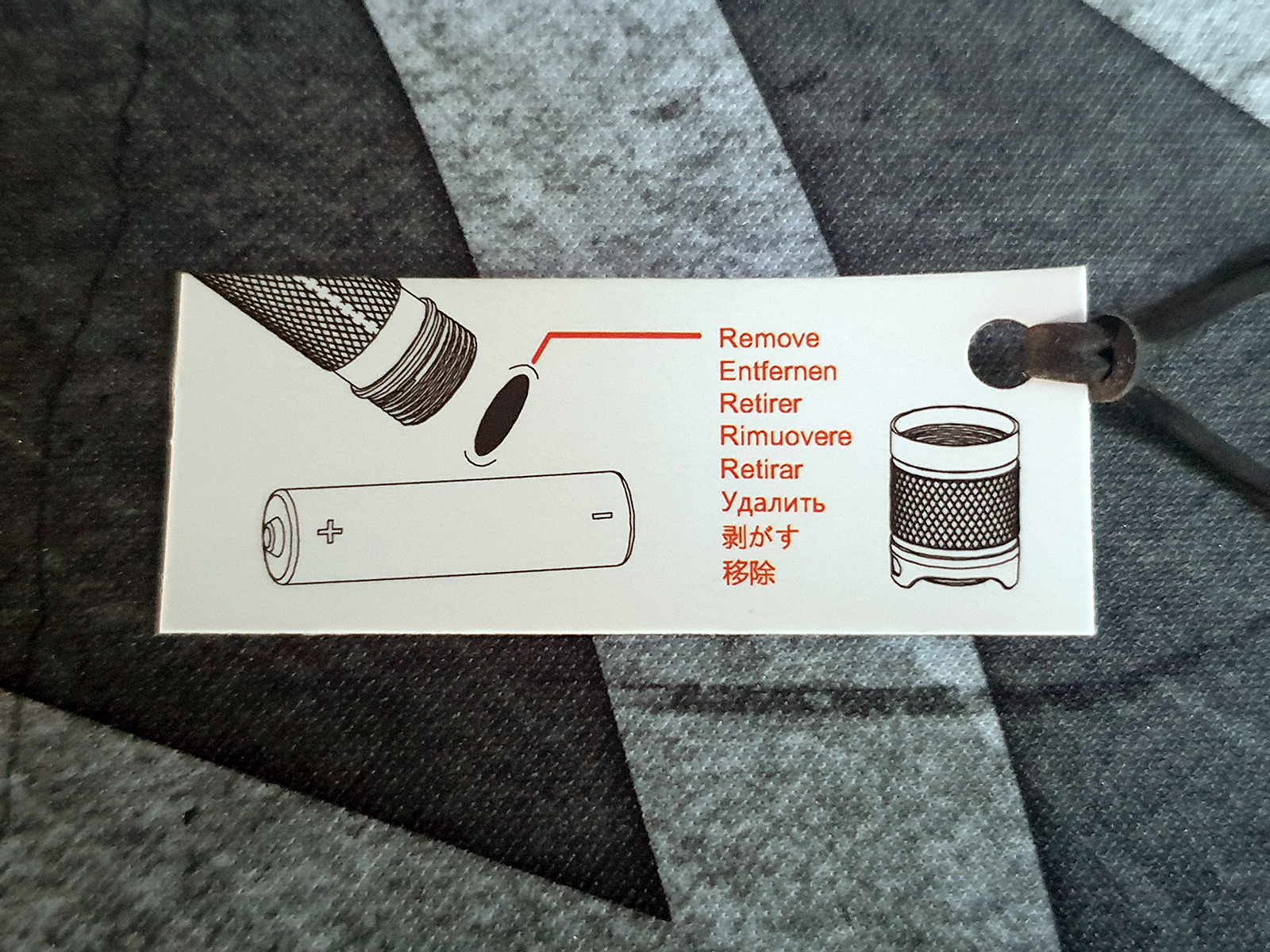

The Sofirn SP36 Pro is a black, cylindrical light, about 12,5cm long and with a diameter of about 5cm at its widest point, which is the front bezel. The body features knurling which allows for a secure grip without being too aggressive. The button is rubbery, textured and slightly raised, so it is easy to find by touch, but can also be pressed while in a bag or in a (very large) pocket. Thankfully, there is a lock out option to cover for that contingency. The area around the button has some heatsinking in the form of fins, while at the exact opposite side there is a rubber flap.


Lifting the flap, reveals the USB C charging port.

Beauty is in the eye of the beholder so I will not presume to tell you if the Sofirn SP36 Pro looks good or not, but I can definitely say that it is an elegant and unassuming design that seems to mean business.




That is even more true about the business end of the light, which features a quadruple smooth reflector with deep enough cups to ensure a healthy amount of throw. The emitters at the bottom of those cups are 4 Luminous SST40, 6500K LEDs.

The battery compartment can be accessed by unscrewing the light into two halves and contains 3 batteries. The front side has an insulator covering which must be removed to reveal the circular battery contacts.

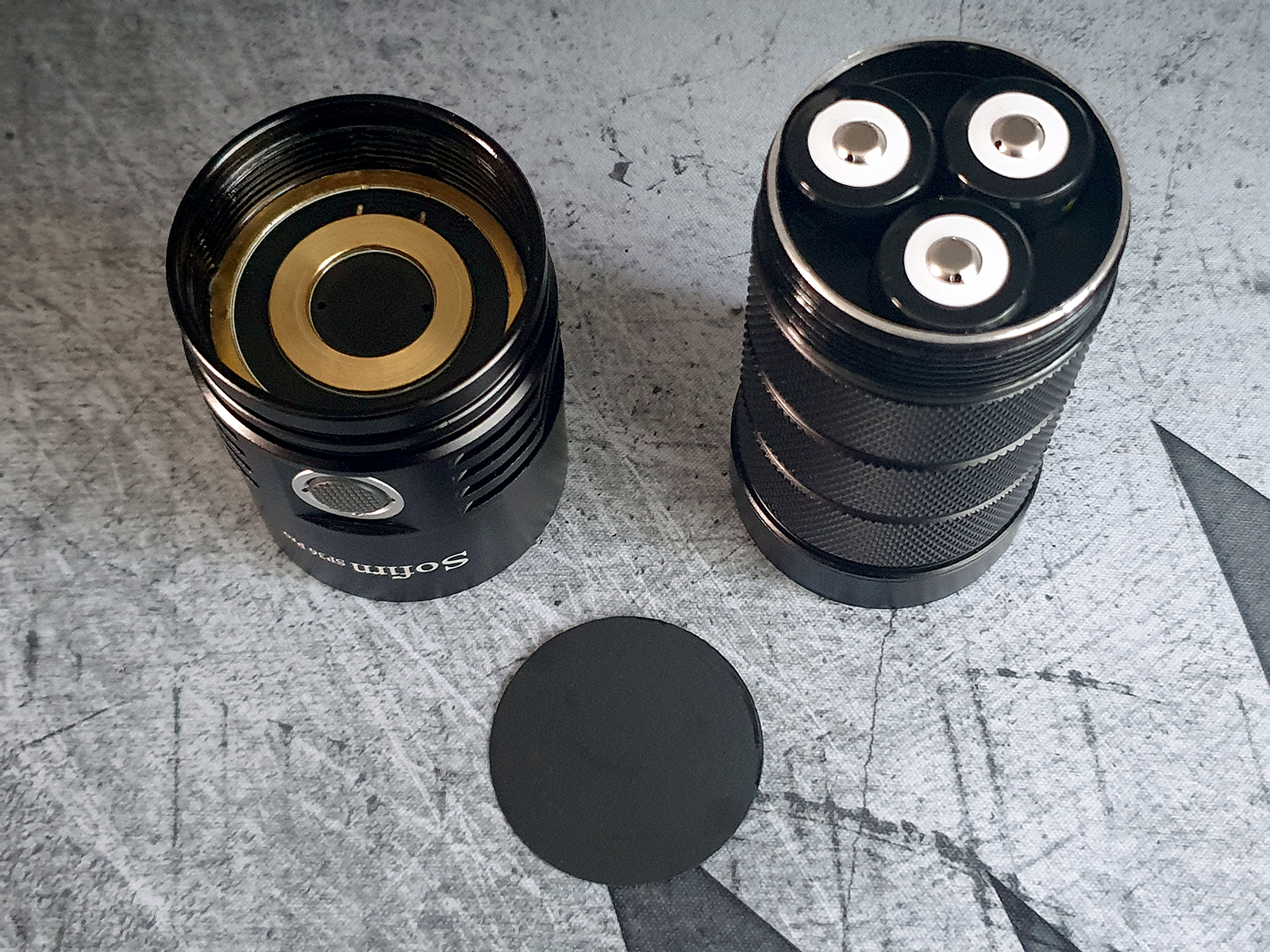
The batteries are Sofirn branded, size 18650 and rated at 3000mAh.

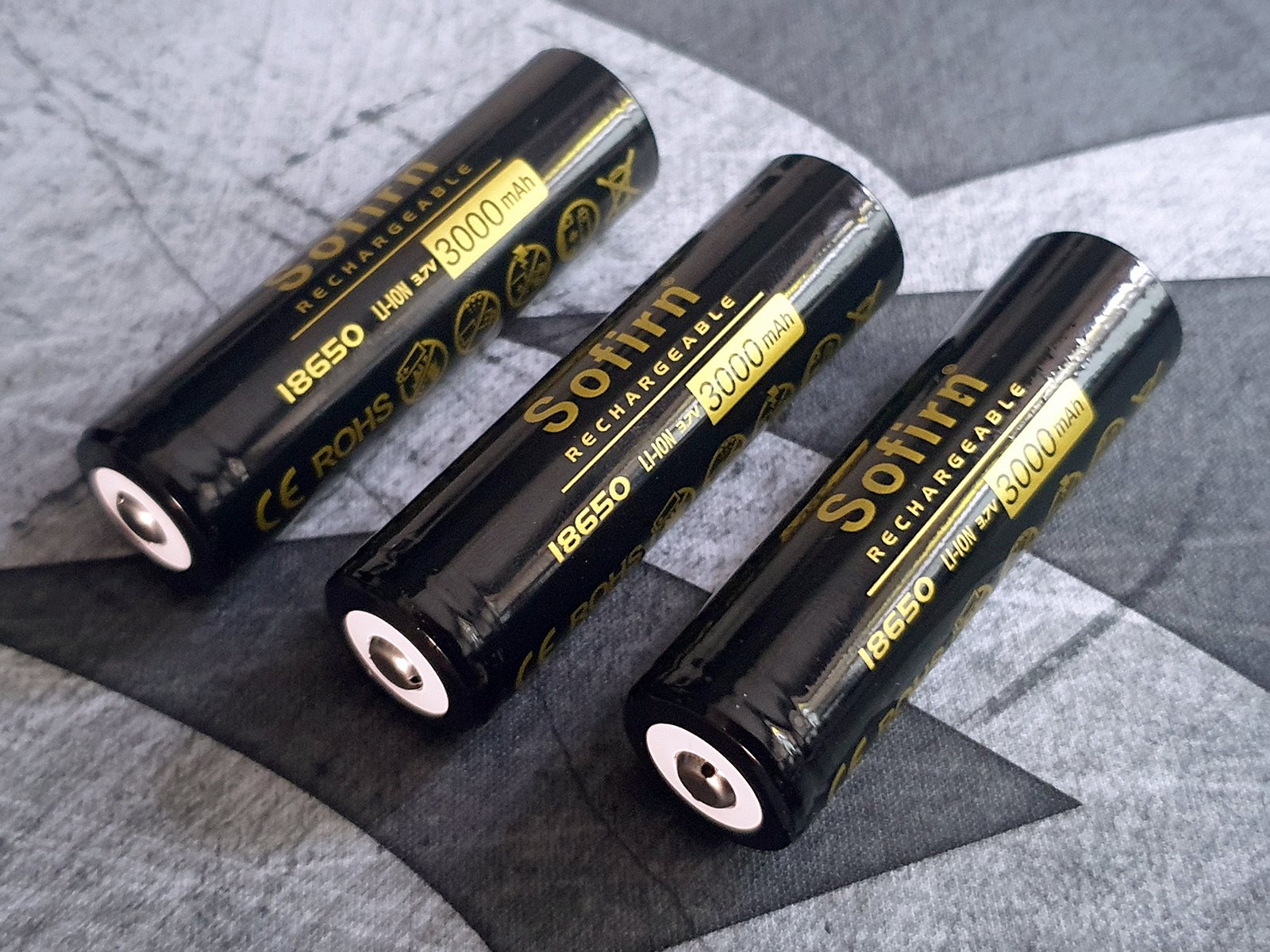
The inner circular battery contact is for the positive contacts of the 3 batteries while the outer circular battery contact gets the negative via the metal body of the battery compartment. The metal body of the battery compartment gets the negative from the batteries through 3 thick double springs at its bottom. The thickness of the springs, the fact that they are double and the whole design seems capable of transferring the power of the batteries to the light's driver circuit with minimal losses. It is also easy to mechanically lock out the light by unscrewing the battery compartment by half a turn, thus breaking the contact between its non anodized lip and the outer circular contact of the head.
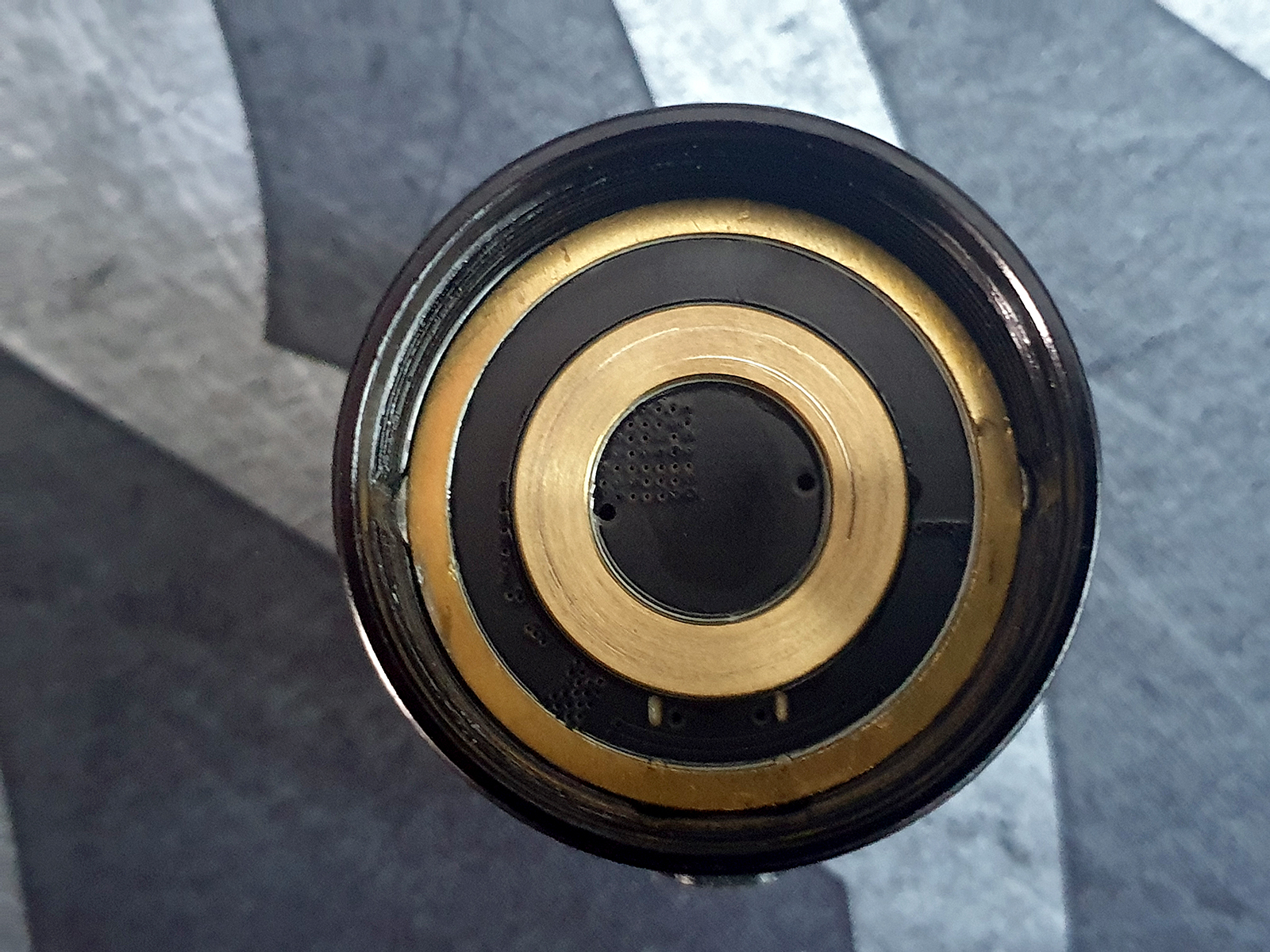
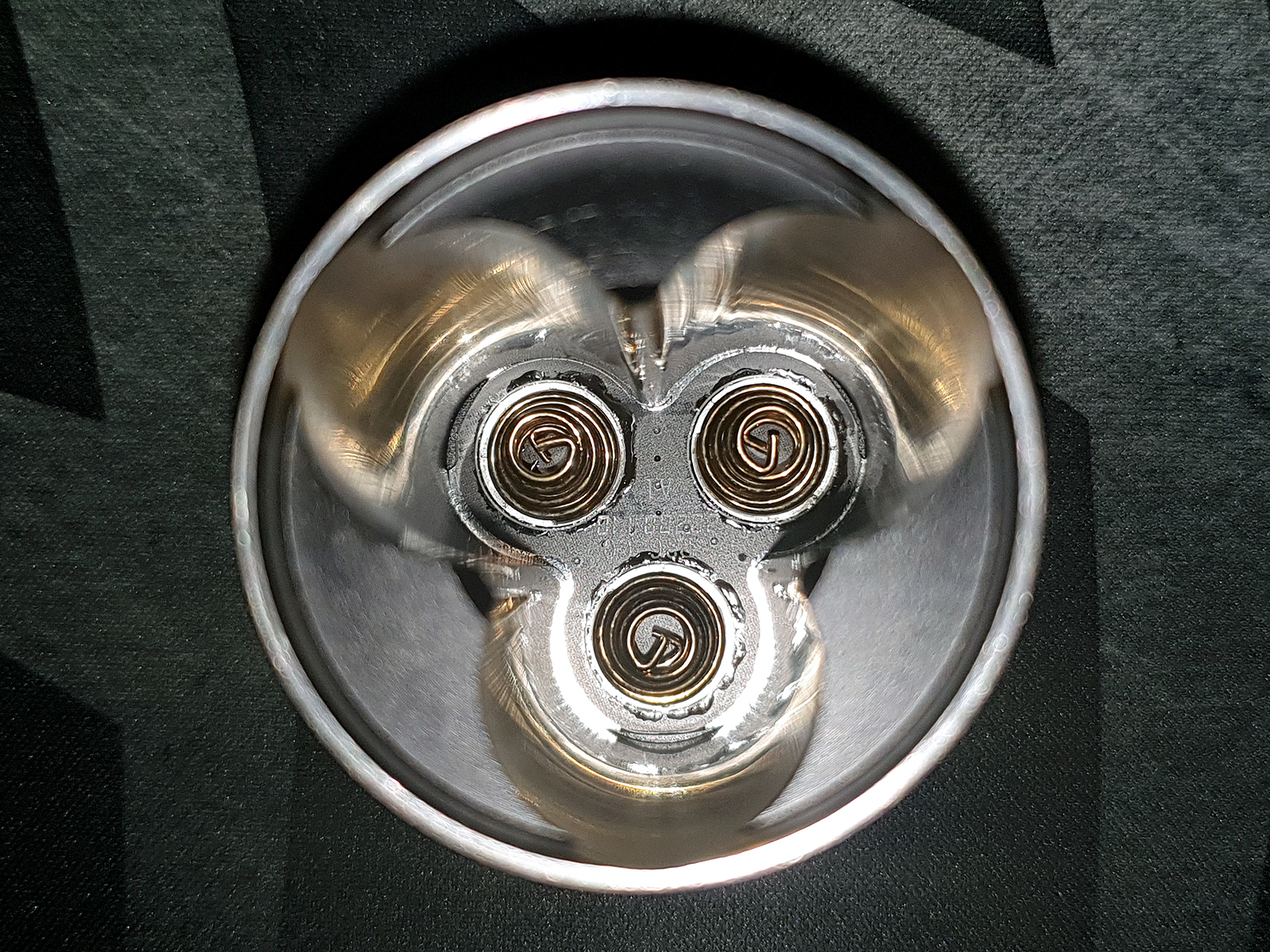
With the insulator out of the way, the Sofirn SP36 Pro is ready for action, which is indicated by the 2 green indicator LEDs on the switch.

Quality
The build quality of the Sofirn SP36 Pro is surprisingly good - for the price point and feature set - and on par with other Sofirn lights.
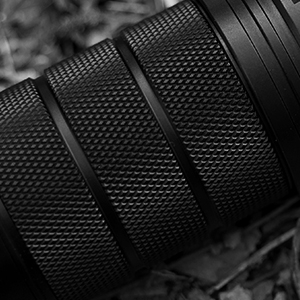
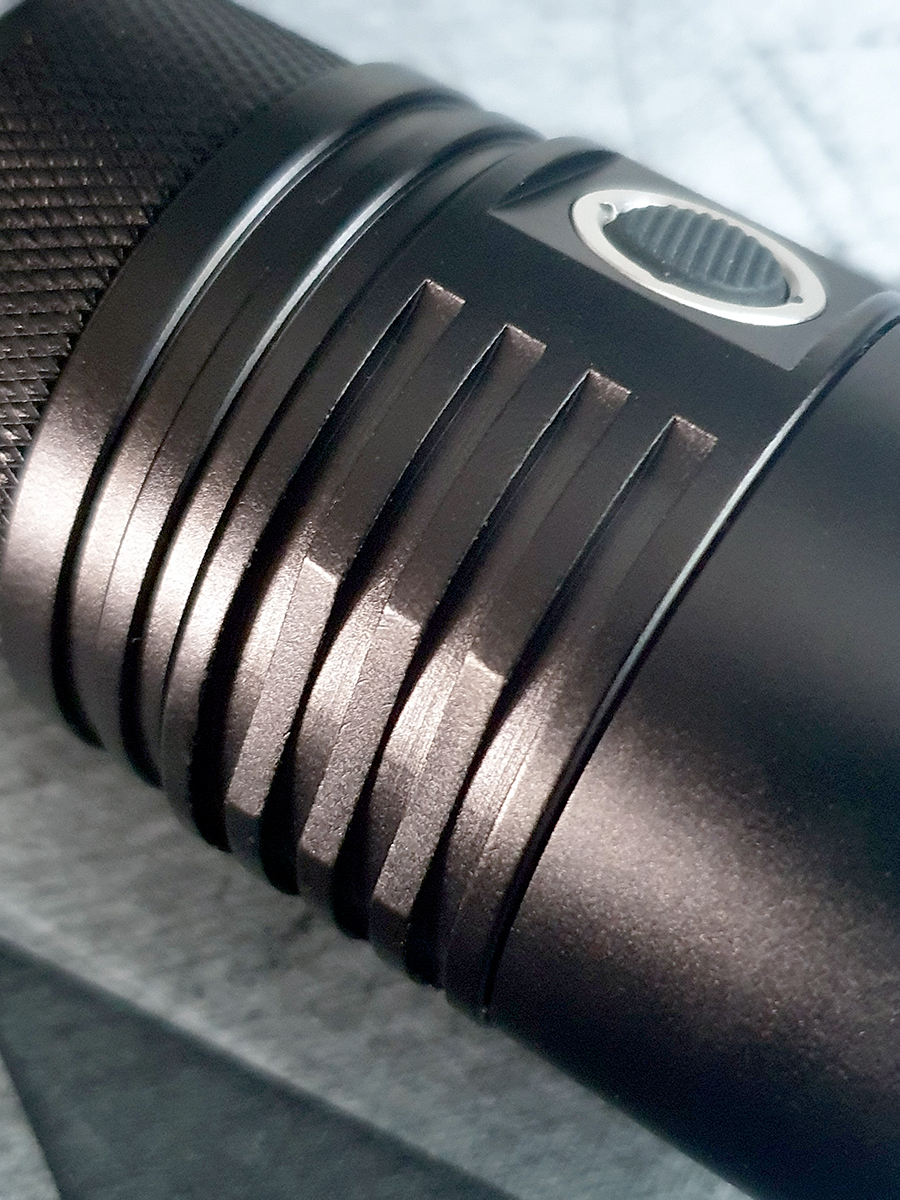
The fit and finish are excellent, the knurling is of good quality and the anodization is without any flaws, except a few points at the edge of the cooling fins. The edges of the fins are also somewhat sharp, not enough to cut, but if you run your finger against them they seem like they would benefit from a little refining.
Specifications
The specifications of the Sofirn SP36 Pro, as found on the company's website, are as follows:

The light features 4 SST40 emitters at 6500K (cool white - there is also a neutral white version at 5000K) which provide 8000 lumen of max output and 450m of max throw. It is made of aerospace grade aluminium and is 126,7mm long and 50mm wide (which I verified to be correct). The weight without the batteries is 300g (I measured 297g without the batteries and 437g with the batteries).

The Sofirn SP36 Pro is USB C rechargeable and rated IPX8.

User Interface
The user interface of the Sofirn SP36 Pro is a love or hate deal, as the light features the Andúril UI. Personally, I love it and deeply enjoy the fact that it is feature packed but still provides simple, quick and intuitive access to the basic functions. Others hate it and consider it too much work, as the manual is extensive and even the flow chart found at the company's website can be intimidating to look at.
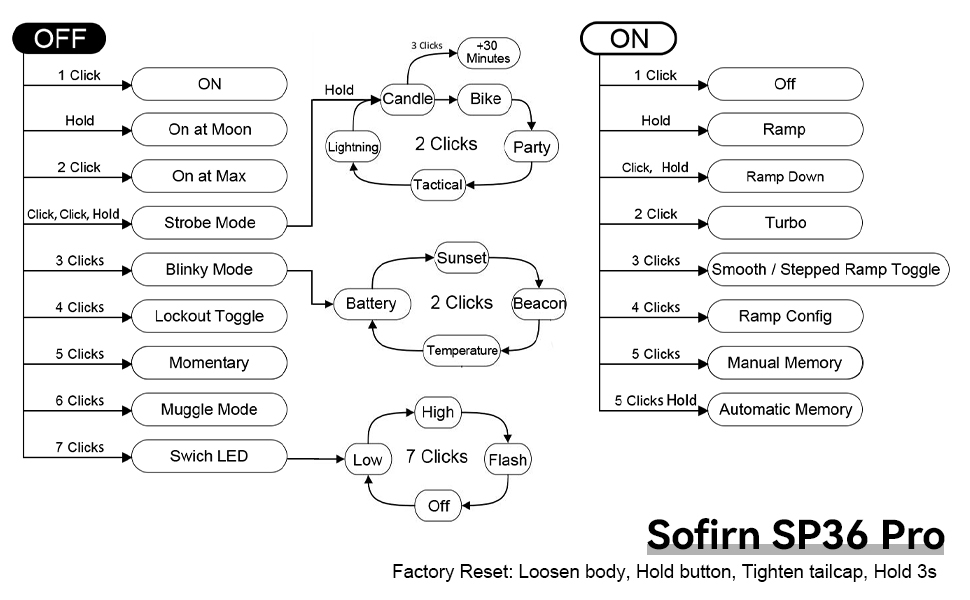
There is another kind of flow chart, provided for Andúril by the coder, which I personally prefer. They are different approaches to the same user interface:
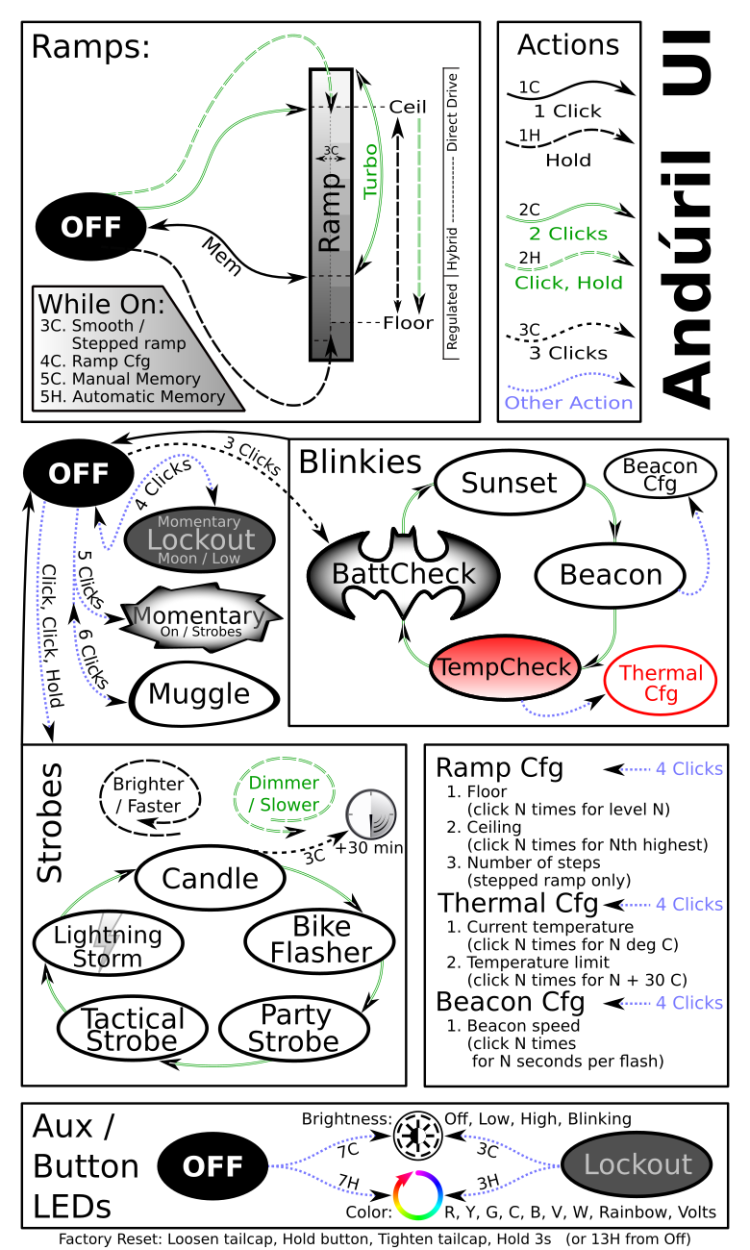
In my experience, after the initial shock, it is very easy to start using the light and have an occasional look at the flow chart to remind oneself of the more advanced functions.
An important thing to do when you take any Andúril light out of the box is to perform a temperature calibration, as the light will depend on it to perform proper thermal control and balance brightness with temperature. That is also the best time to set the temperature limit. I find 50C to be a good temperature limit and the tests done in this review were done on a calibrated light and with a 50C temperature limit.
Beam-shots
The beam pattern of the Sofirn SP36 Pro is a product of the LED type and size and the reflector it uses. With the 5x5mm SST40 emitters and smooth reflector, it is not surprising that the result is a somewhat tight hot spot that throws nicely, surrounded by a nice, usable spill. All in all, a very balanced and usable beam pattern.
There are various rings and coronas that are typical of smooth reflectors and of multi emitter lights and may annoy white wall hunters, but those are unavoidable in this configuration and do not cause any problems in real world use.

I tested the Sofirn SP36 Pro over a distance of 70m.

The following video shows a comparison of the Sofirn SP36 Pro with the Olight X7R, the Fireflies E07 (Nichia 219b sw45k) and the Lumintop X9L.
Driver
The driver of the Sofirn SP36 Pro uses PWM to dim the light, on all levels, except, of course, on full. The PWM is visible to the camera but not visible to the naked eye, on any level.

Even though I prefer constant current drivers, PWM is an efficient and cost effective way to achieve LED dimming and if it is done at a high enough frequency, as seems to be the case here, it is not a problem.
Tint
The tint of the Sofirn SP36 Pro is the cool, greenish (above BBL) tint that is expected of the Luminous SST40 emitter. It is very similar to the tint of the Olight X7R. Next to them, for reference, the Fireflies E07 with Nichia 219b sw45k emitters which are high CRI and very rosy (below BBL) and the Lumintop X9L which uses a Luminous SBT90.2 emitter. The SST40 used in the Sofirn SP36 Pro is not high CRI.

Charging
The batteries included with the Sofirn SP36 Pro are rated at 3000mAh and I measured them to be right around that number (2950mAh / 3060mAh / 3049mAh) The light has under voltage protection and turns off when the battery voltage drops to 2.8V. The batteries' internal resistance was measured at around 120mΩ.
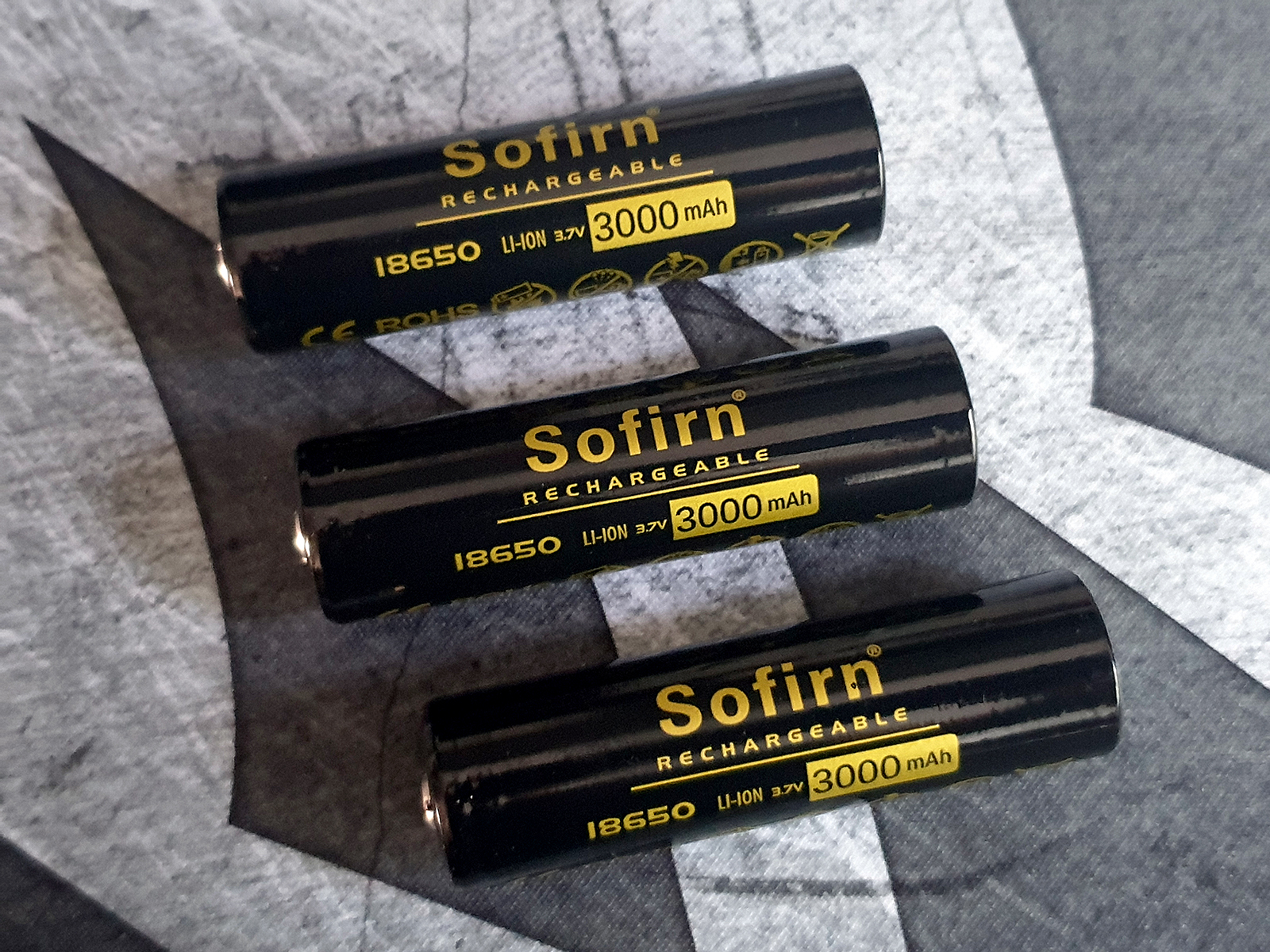
Charging the Sofirn SP36 Pro is very easy. Just lift the rubber cover and insert the provided USB type C cable to charge the light.

The indicative LEDs on the switch turn red to indicate the light is charging. They turn green when the charging is completed, at 4.22V.



Charging the Sofirn SP36 Pro from 2.8V to 4.22V took 4 hours, 57 minutes and 17 seconds. The maximum current drawn was 1.8712A, so a charger that can provide at least 2A is recommended. A charger is not provided with the light but you can use your phone charger.

Current Draw
The Sofirn SP36 Pro has a very low parasitic drain that is below the ability of the clamp meter to measure. It shows between 0mA and 1mA, with the indicative LEDs on the switch, on (they can be turned off through the Andúril UI). The light also has a very low moonlight mode that only draws 3mA. The top of the ramp drew 5.93A and Turbo required 16.34A.

You can run the Sofirn SP36 Pro with all 3 batteries or with 2 or even 1 battery. Each of the batteries provided with the Sofirn SP36 Pro can give up to 10A (tested) so in order to get full brightness on Turbo you need to use at least 2 batteries in the light. All measurements were taken with all 3 batteries in the light.
Output & Runtimes
The Sofirn SP36 Pro is rated at 8000 lumen output and 450m of throw. I measured it both with batteries fresh off the charger and after they had rested.
With batteries fresh off charging, the maximum output (at turn on) was 7417 lumen, which is short of the advertised 8000 but still very respectable for the size of the light. ANSI output (at 30 seconds) was 6716 lumen and at 2 minutes the output had dropped to 1490 lumen. It then gradually increased to 1767 lumen until the 5 minute mark. Over the next 30 seconds the output dipped to only 300 lumen and gradually increased to over 500 lumen over the next 15 minutes, to stay at around that level until the 5 hours and 40 minutes mark.
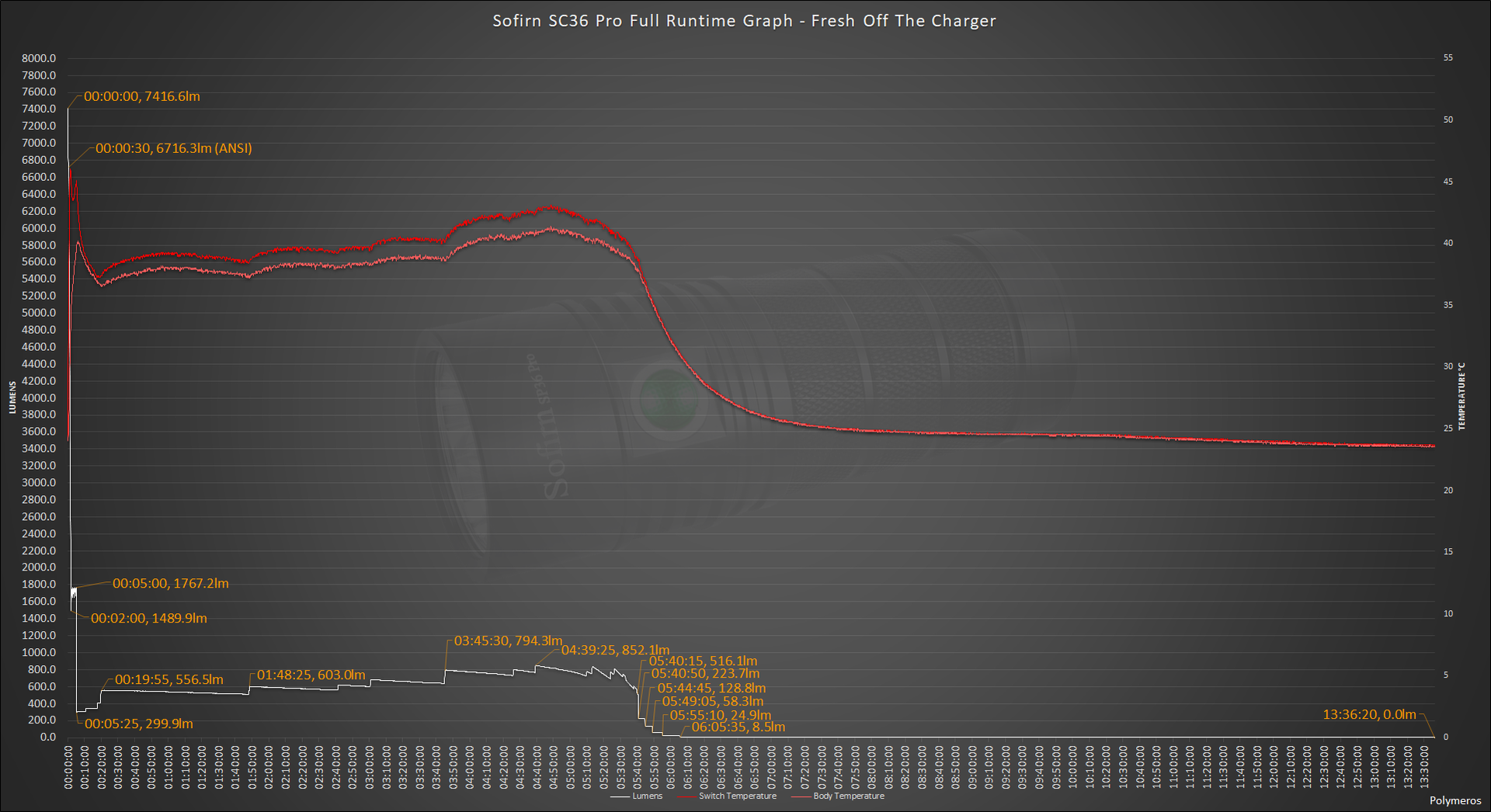
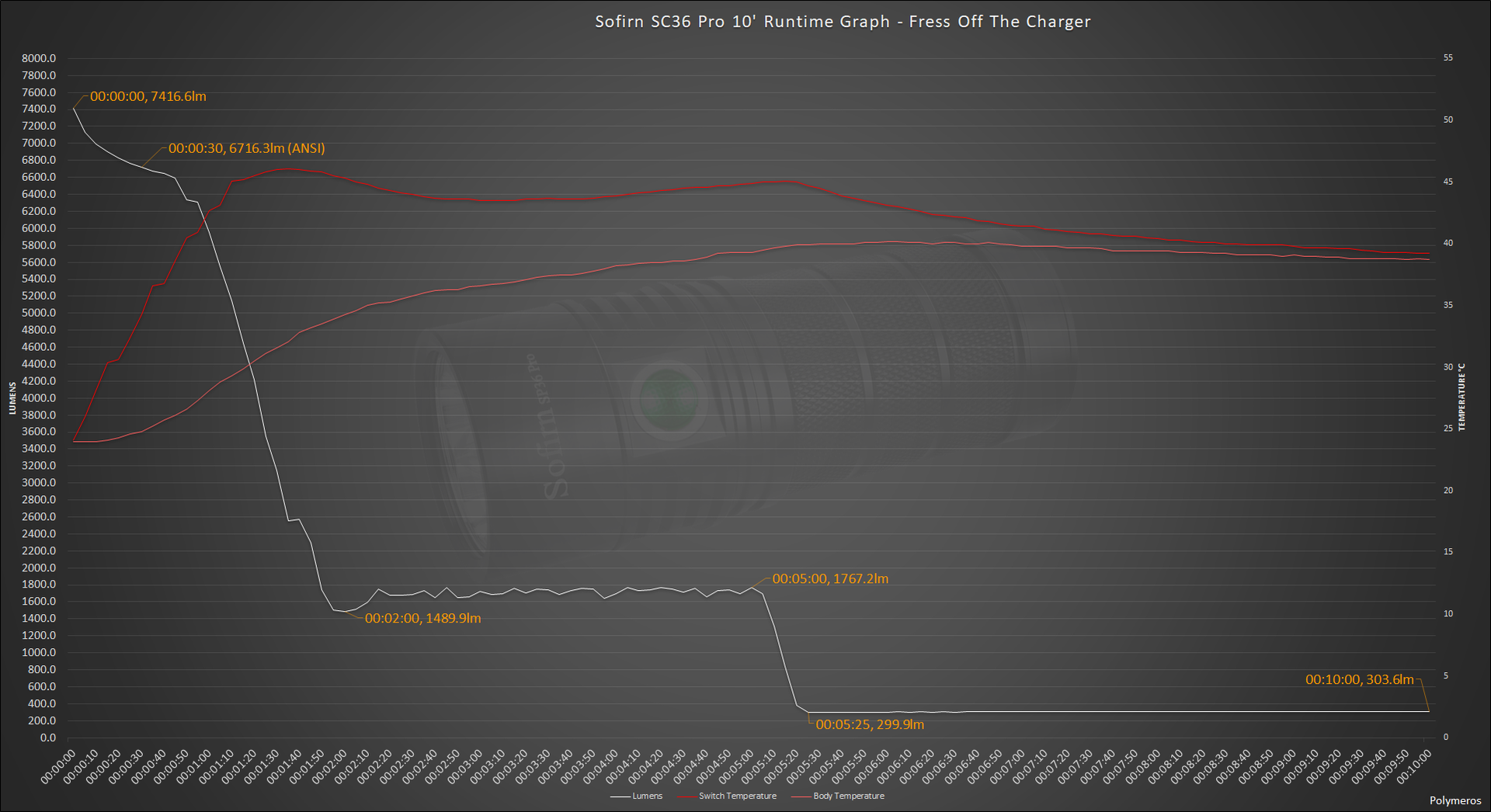
With rested batteries, the maximum output (at turn on) was 6726 lumen, which is 9.3% less than with batteries fresh off the charger. ANSI output (at 30 seconds) was 6364 lumen, which is 5.2% less than with batteries fresh off the charger. At 2 minutes the output had dropped to 2327 lumen, which is 36% more than with batteries fresh off the charger. It seems the initial extra burst of energy that the batteries can give fresh off the charger has a big toll! The output gradually decreased to 2190 lumen until the 4 minutes and 5 seconds mark and over the next 20 seconds the output dipped to 518 lumen, where it remained stable, gradually increasing over the next hours, to reach a maximum of 931 lumen at 5:13:55. It then dropped gradually, to 222 lumen, at 5:40:10.
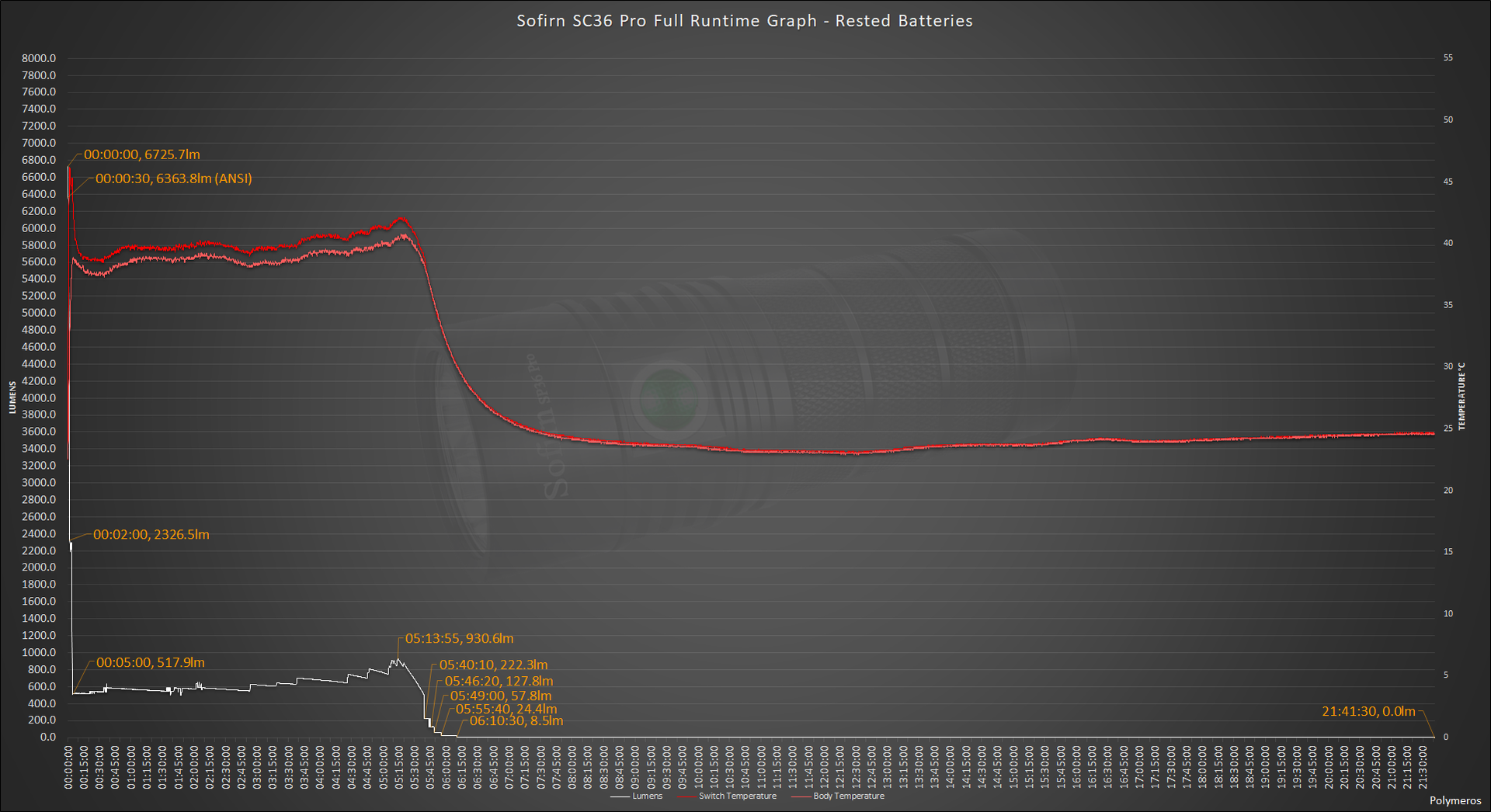
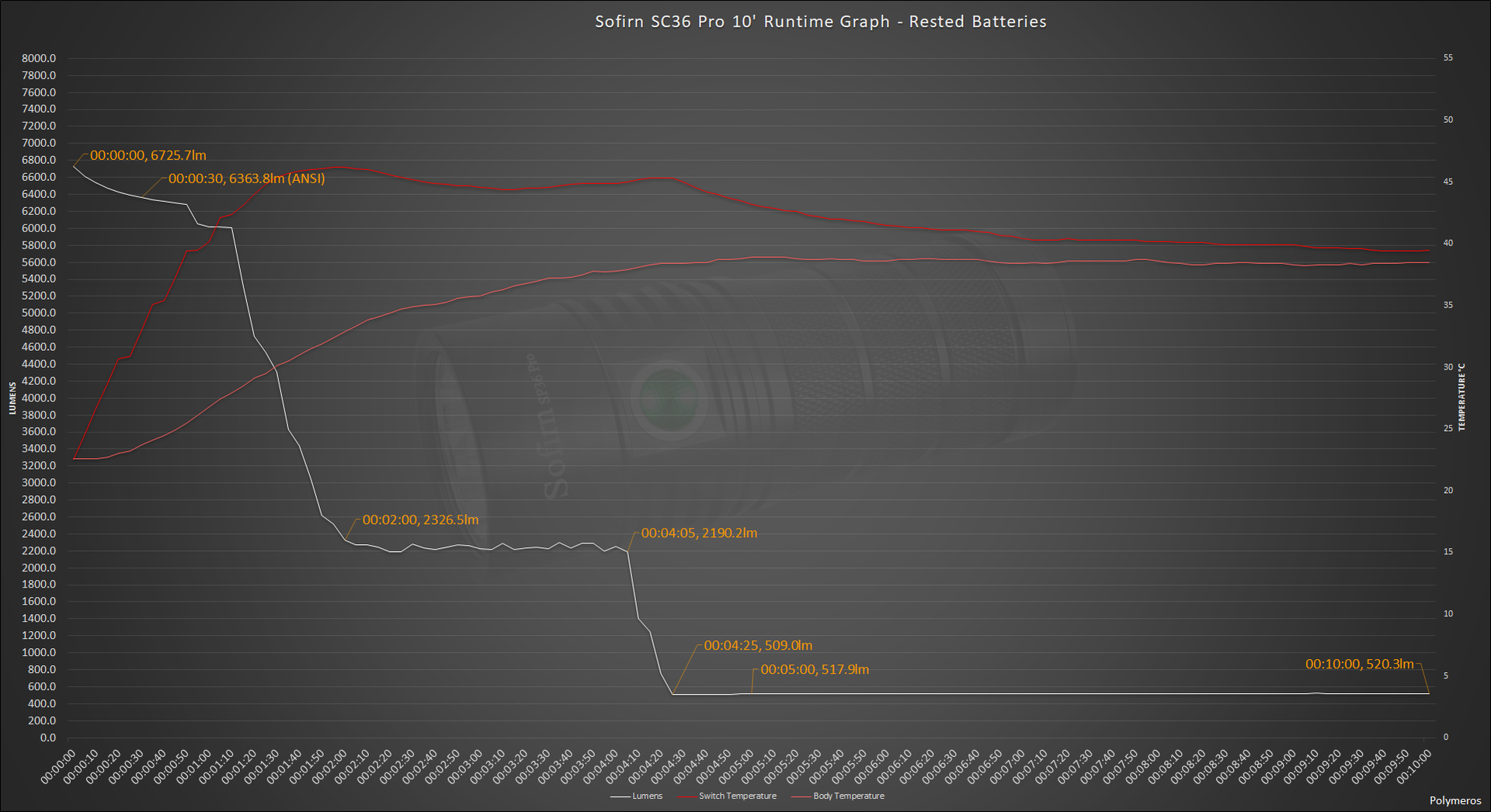
From these 2 scenarios it is obvious that even though the batteries fresh off the charger will give a bigger, more impressive boost, the advantage lasts about a minute and has consequences for the entire runtime of the light. Moreover, it is highly unlikely it will happen in real life anyway, as most people do not keep the light on charging all the time.
The temperature was very well controlled, as you can see in the runtime graphs. Turning on the light at Turbo, will cause a rapid rise in temperature, followed by a big dip in output, while the temperature stabilizes. This can be avoided if the light is not on Turbo, but used at a more moderate output level.
The light was temperature calibrated, according to the manual, and the temperature limit was set at 50C. The actual temperatures on the button and on the body of the light can be seen on the graphs and were kept well within the set limit.
All in all, the Sofirn SP36 Pro gave very usable light for about 5.5 hours, when turned on at Turbo, which is very respectable. Usage at more moderate levels, will of course, result in higher runtimes and lower, if any, output dips, due to temperature management.
The maximum intensity of the light, with rested batteries, was measured at 56784 cd, which translates to a throw of 476,59m, which is 5.9% more than the 450m advertised.
Conclusion
The Sofirn SP36 Pro is a value for money, Soda Can sized light that will not disappoint. Its aluminium body is well made and hard anodized and the fit and finish is beyond its price point. The mildly sharp edges of the fins are not a concern, but could have been smoother.
The size and weight are great for its output rating and the 3 provided 3000mAh 18650 batteries allow for ample runtime. The output is more than enough for most purposes and the beam profile is very balanced.
The tint of the Luminous SST40 LED is a cool, above BBL (greenish) tint and the CRI is low, but this is countered by the high lumen output this emitter allows the light to achieve.
The driver uses PWM to dim the output, so PWM is present at all output levels, except on full. The frequency of the PWM is high enough to not be visible to the naked eye and did not tire me when using the light.

The Sofirn SP36 Pro can be purchased from the Sofirn Website and the cost at the moment this review is written is $49.99, including shipping, worldwide. That is a lot of torch for the money!
Let's list the Pros and Cons of the Sofirn SP36 Pro:

Pros
+ Value for money
+ High output and throw
+ Aerospace grade Aluminium Alloy construction with good fit and finish
+ USB type C charging
+ Low Voltage Protection
+ Thermal regulation
+ Well balanced beam
+ 3x 18650 Li-Ion 3000mAh (actually measured) batteries included
+ Low power and charging LED indicator
+ Andúril UI
+ Lighted button with indicative LEDs
+ IP68
+ At least 5.5 hours of usable light per charge
+ Compatible with all button top 18650 batteries

Cons
- The fins could have smoother edges
- The driver uses PWM to dim the emitter
Thanks to Sofirn for providing the light for review
Polymeros Achaniotis 30/07/2021
-
 6
6



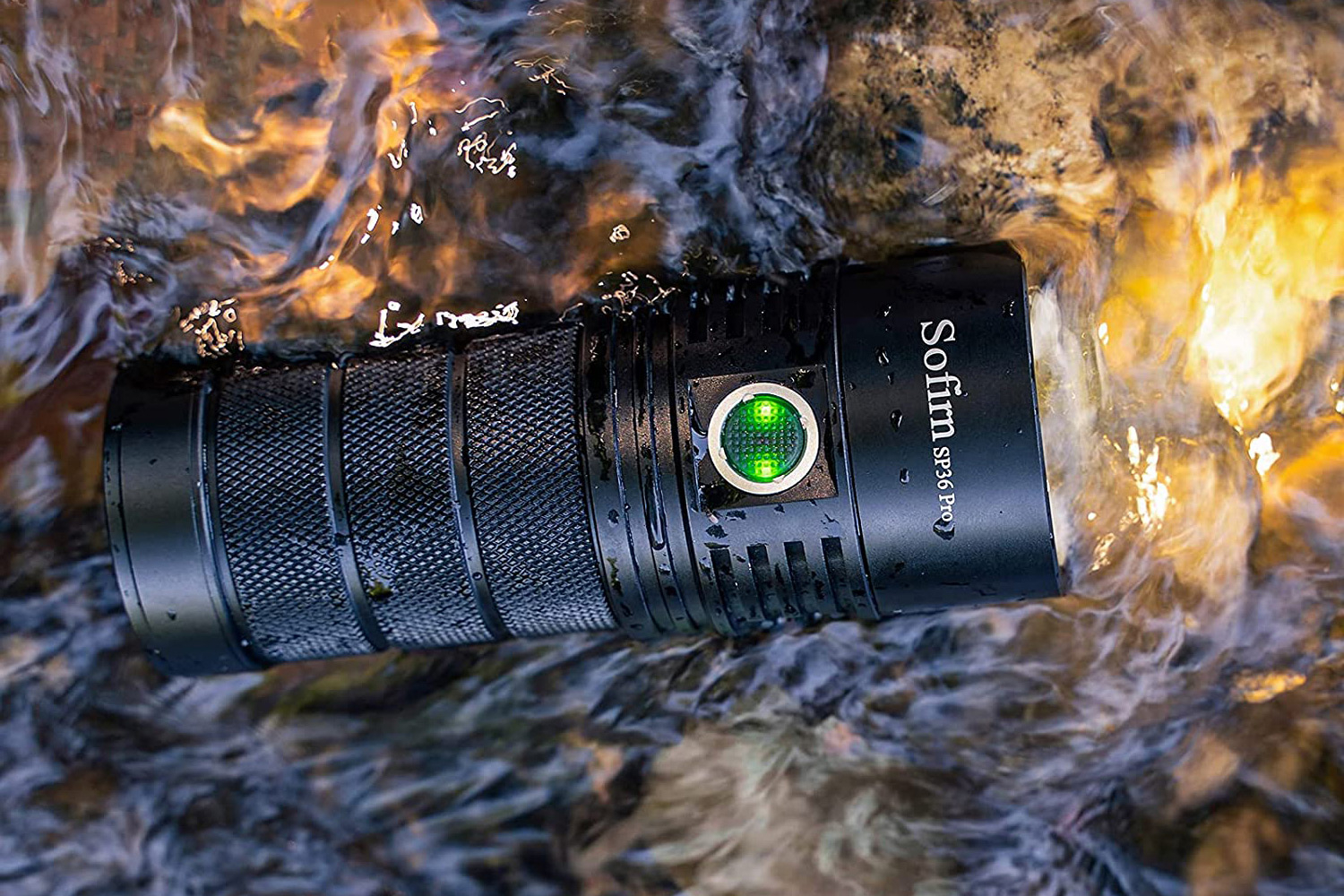





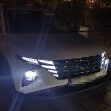

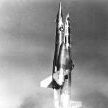

Recommended Comments
Create an account or sign in to comment
You need to be a member in order to leave a comment
Create an account
Sign up for a new account in our community. It's easy!
Register a new accountSign in
Already have an account? Sign in here.
Sign In Now